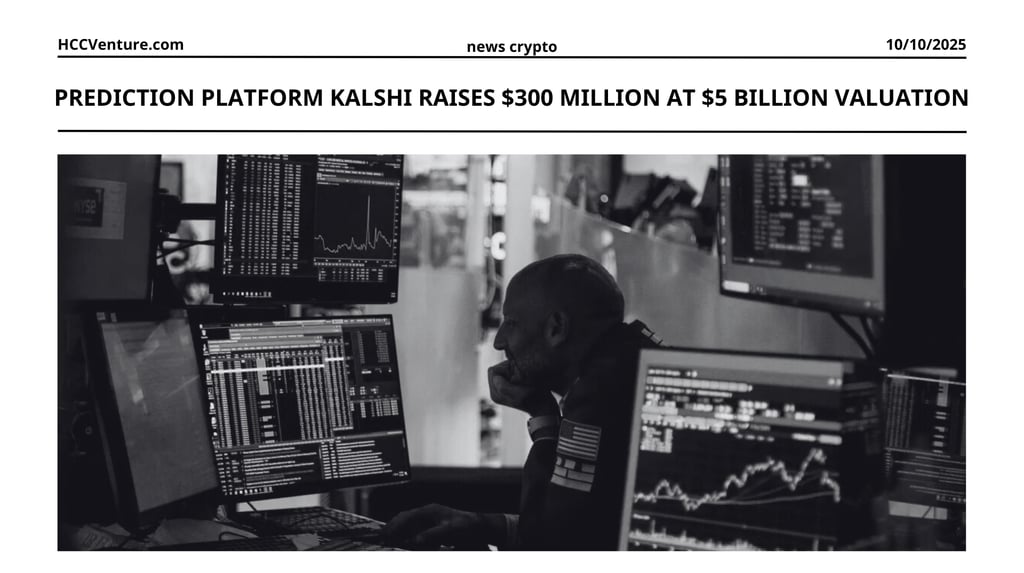Prediction Platform Kalshi Raises $300 Million at $5 Billion Valuation
Prediction market darling Kalshi has closed more than $300 million in a new Series D funding round at a whopping $5 billion valuation, doubling its June valuation and arming it with the CFTC.
10/10/20252 min read


Poly Market's Rival
Kalshi, a prediction market platform regulated and backed by the U.S. Commodity Futures Trading Commission (CFTC), has raised more than $300 million in new capital, valuing it at $5 billion. The company plans to use the capital to expand internationally to more than 140 countries, marking one of the most aggressive global growth initiatives ever undertaken in the prediction market space.
The funding round – said to be led by a group of sovereign wealth funds, global asset managers and fintech investors – cements Kalshi’s position as the leading managed event trading platform, bridging the gap between traditional finance and blockchain-inspired prediction markets.
Founded in 2018 and approved by the CFTC in 2020, Kalshi operates as a Designated Contract Market (DCM) — a rare regulatory status that allows users to trade on real-world events, from inflation data and election results to entertainment, weather, and corporate milestones.
While blockchain-based competitors like Polymarket and PredictIt rely on decentralized structures to operate globally, Kalshi has chosen the opposite path: full legal legitimacy under US law. This approach has paid off, allowing Kalshi to attract institutional liquidity and the trust of mainstream users.
The new $300 million round will fund:
International licensing and compliance efforts across Europe, Asia and Latin America.
Diversify products into new event categories, including sports, geopolitics, and economic data.
Expand infrastructure for retail and institutional participation.
Research and Development of Web3 interoperability, allowing blockchain users to hedge and speculate on real-world outcomes through regulated markets.
Prediction market war
Kalshi’s rise to a $5 billion valuation marks a turning point in the transition of prediction markets—once considered niche or speculative—into mainstream financial infrastructure. Kalshi’s regulation-first model could serve as a blueprint for future event-based derivatives globally.
By offering CFTC-cleared markets, Kalshi enables institutional traders to use event contracts as hedging tools, not just speculative instruments. Examples include:
Hedging against CPI releases, Fed rate decisions or election results.
Incorporating event probability into macro hedge fund strategies.
This opens up a new horizon where prediction markets evolve into data-driven macro instruments that are liquid and relevant similar to options or futures.
As Kalshi expands to over 140 countries, Kalshi’s compliance-first model could influence global financial regulators, encouraging more formal recognition of event trading as a legitimate asset class — and potentially pushing decentralized competitors toward hybrid compliance structures.
Kalshi’s centralized and regulated approach contrasts with original blockchain projects like Polymarket, Zeitgeist, and Gnosis, which prioritize transparency and censorship resistance. However, global expansion will likely converge with Web3 infrastructure over time — especially if Kalshi integrates on-chain data or stablecoin payments to increase payment efficiency.
Evaluation and Conclusion
Kalshi’s $300 million funding round and $5 billion valuation mark a historic turning point in the evolution of event-driven financial products. By combining the principles of traditional finance with the vision of decentralized markets, Kalshi is poised to redefine how people and institutions trade on information, probability, and trust. If its global expansion is successful, Kalshi could become the Bloomberg and CME of prediction markets—a hub where the world prices not just assets but outcomes.
Disclaimer: The information presented in this article is the author's personal opinion in the cryptocurrency field. It is not intended to be financial or investment advice. Any investment decision should be based on careful consideration of your personal portfolio and risk tolerance. The views expressed in this article do not represent the official position of the platform. We recommend that readers conduct their own research and consult with a professional before making any investment decisions.
Explore HCCVenture group
HCCVenture © 2023. All rights reserved.


Connect with us
Popular content
Contact to us
E-mail : holdcoincventure_contact@hccventure.com
Register : https://linktr.ee/holdcoincventure
Disclaimer: The information on this website is for informational purposes only and should not be considered investment advice. We are not responsible for any risks or losses arising from investment decisions based on the content here.


TERMS AND CONDITIONS • CUSTOMER PROTECTION POLICY
ANALYTICAL AND NEWS CONTENT IS COMPILED AND PROVIDED BY EXPERTS IN THE FIELD OF DIGITAL FINANCE AND BLOCKCHAIN BELONGING TO HCCVENTURE ORGANIZATION, INCLUDING OWNERSHIP OF THE CONTENT.
RESPONSIBLE FOR MANAGING ALL CONTENT AND ANALYSIS: HCCVENTURE FOUNDER - TRUONG MINH HUY
Read warnings about scams and phishing emails — REPORT A PROBLEM WITH OUR SITE.
